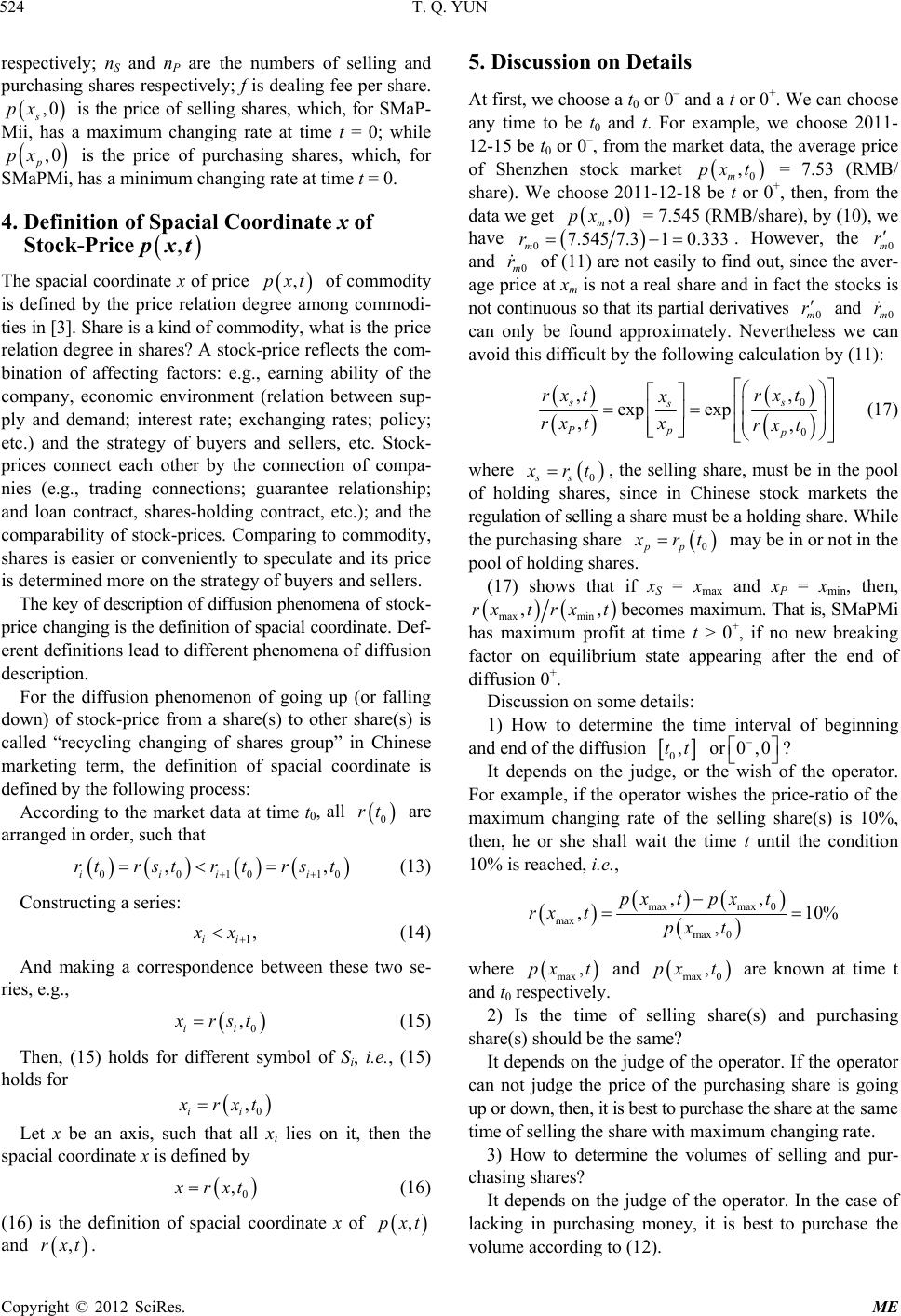
T. Q. YUN
524
respectively; nS and nP are the numbers of selling and
purchasing shares respectively; f is dealing fee per share.
s is the price of selling shares, which, for SMaP-
Mii, has a maximum changing rate at time t = 0; while
p is the price of purchasing shares, which, for
SMaPMi, has a minimum changing rate at time t = 0.
,0px
,0px
,pxt
,pxt
4. Definition of Spacial Coordinate x of
Stock-Price
The spacial coordinate x of price of commodity
is defined by the price relation degree among commodi-
ties in [3]. Share is a kind of commodity, what is the price
relation degree in shares? A stock-price reflects the com-
bination of affecting factors: e.g., earning ability of the
company, economic environment (relation between sup-
ply and demand; interest rate; exchanging rates; policy;
etc.) and the strategy of buyers and sellers, etc. Stock-
prices connect each other by the connection of compa-
nies (e.g., trading connections; guarantee relationship;
and loan contract, shares-holding contract, etc.); and the
comparability of stock-prices. Comparing to commodity,
shares is easier or conveniently to speculate and its price
is determined more on the strategy of buyers and sellers.
The key of description of diffusion phenomena of stock-
price changing is the definition of spacial coordinate. Def-
erent definitions lead to different phenomena of diffusion
description.
For the diffusion phenomenon of going up (or falling
down) of stock-price from a share(s) to other share(s) is
called “recycling changing of shares group” in Chinese
marketing term, the definition of spacial coordinate is
defined by the following process:
According to the market data at time t0, all
0
rt are
arranged in order, such that
1010
,
i i
rs t
1,
ii
00
,
ii
rtrstrt (13)
Constructing a series:
x
0
,
ii
(14)
And making a correspondence between these two se-
ries, e.g.,
rs t (15)
Then, (15) holds for different symbol of Si, i.e., (15)
holds for
0
,
ii
rxt
0
,
Let x be an axis, such that all xi lies on it, then the
spacial coordinate x is defined by
rxt (16)
(16) is the definition of spacial coordinate x of
5. Discussion on Details
,pxt
and
,rxt
,pxt
.
At first, we choose a t0 or 0– and a t or 0+. We can choose
any time to be t0 and t. For example, we choose 2011-
12-15 be t0 or 0–, from the market data, the average price
of Shenzhen stock market 0m = 7.53 (RMB/
share). We choose 2011-12-18 be t or 0+, then, from the
data we get
,0
m
px = 7.545 (RMB/share), by (10), we
have
7.545 7.310.333
m
r r
0. However, the 0m
and 0m of (11) are not easily to find out, since the aver-
age price at xm is not a real share and in fact the stocks is
not continuous so that its partial derivatives 0m and 0m
can only be found approximately. Nevertheless we can
avoid this difficult by the following calculation by (11):
r
&
rr
&
0
0
,,
exp exp
,,
ss
s
Pp p
rxt rxt
x
rx txrx t
(17)
0ss
where rt
0pp
, the selling share, must be in the pool
of holding shares, since in Chinese stock markets the
regulation of selling a share must be a holding share. While
the purchasing share
rt may be in or not in the
pool of holding shares.
(17) shows that if xS = xmax and xP = xmin, then,
maxmin becomes maximum. That is, SMaPMi
has maximum profit at time t > 0+, if no new breaking
factor on equilibrium state appearing after the end of
diffusion 0+.
,,rxtrxt
Discussion on some details:
1) How to determine the time interval of beginning
and end of the diffusion
0
It depends on the judge, or the wish of the operator.
For example, if the operator wishes the price-ratio of the
maximum changing rate of the selling share(s) is 10%,
then, he or she shall wait the time t until the condition
10% is reached, i.e.,
,tt 0,
0
or?
maxmax 0
max
max 0
,,
,10%
,
px tpx t
rx tpx t
,px t
max and
where
max 0
,pxt are known at time t
and t0 respectively.
2) Is the time of selling share(s) and purchasing
share(s) should be the same?
It depends on the judge of the operator. If the operator
can not judge the price of the purchasing share is going
up or down, then, it is best to purchase the share at the same
time of selling the share with maximum changing rate.
3) How to determine the volumes of selling and pur-
chasing shares?
It depends on the judge of the operator. In the case of
lacking in purchasing money, it is best to purchase the
volume according to (12).
Copyright © 2012 SciRes. ME